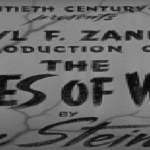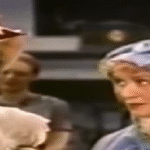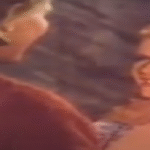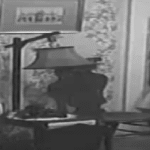The 1910 silent film adaptation of A Christmas Carol, produced by the Thomas Edison Company, is among the earliest cinematic interpretations of Charles Dickens’ beloved novella. Though the film’s duration is a mere twelve minutes, it captures the spirit of Dickens’ story with remarkable economy, relying on expressive performances and simple visual effects to convey its message of redemption and goodwill.
The story begins with an introduction to Ebenezer Scrooge, a miserly old businessman whose heart is hardened by greed and selfishness. Clad in traditional Victorian attire, Scrooge sits in his gloomy counting-house on Christmas Eve, tallying his profits with stern precision. His clerk, Bob Cratchit, shivers in the background, his breath visible in the frigid air, yet Scrooge refuses to provide him with sufficient coal to warm the office.
Scrooge’s disdain for Christmas is made plain when two charitable gentlemen visit his office seeking donations for the poor. He rebuffs them coldly, declaring that he cares not if the needy starve, so long as it does not cost him a penny. Shortly after, his cheerful nephew Fred arrives to invite him to Christmas dinner, only to be dismissed with scorn and ridicule.
As night falls, Scrooge retires to his lonely chambers. There, he is visited by the ghost of his former business partner, Jacob Marley. Draped in heavy chains and bearing a mournful expression, Marley’s spirit warns Scrooge that he is doomed to the same tormented fate unless he changes his ways. Marley foretells the arrival of three spirits who will visit Scrooge throughout the night to show him the error of his ways.
True to Marley’s word, the first spirit—the Ghost of Christmas Past—appears, portrayed as a luminous figure in flowing robes. It transports Scrooge back to his youth, where he sees himself as a lonely schoolboy neglected during the festive season. The film poignantly depicts scenes of a younger, more innocent Scrooge, whose early love of Christmas and human kindness gradually wither under the lure of wealth and ambition.
Next, the Ghost of Christmas Present arrives, represented as a jovial and benevolent figure. He shows Scrooge the humble yet joyful Christmas celebration of the Cratchit family. In their modest home, Bob Cratchit and his family are seen preparing a meagre feast, their love and unity shining despite their poverty. The Cratchits’ sickly son, Tiny Tim, radiates hope and goodwill, famously wishing that God bless “us, every one”. This vision stirs an unfamiliar pang of compassion within Scrooge.
Finally, Scrooge is confronted by the ominous Ghost of Christmas Yet to Come. Shrouded in a dark cloak, the spirit is a menacing figure who reveals a bleak and chilling future. Scrooge sees his own death, unmourned and forgotten. In a graveyard scene, he witnesses his neglected grave, overgrown and crumbling. The Cratchits, too, are shown in mourning, grieving the death of Tiny Tim, whose fragile life might have been saved had circumstances been kinder.
Overwhelmed by terror and remorse, Scrooge begs for the chance to change his destiny. He awakens in his bed, realising it is still Christmas morning. Grateful for the opportunity to redeem himself, he immediately sets about righting his wrongs. He sends a large turkey to the Cratchits, donates generously to charity, and seeks to reconnect with his nephew Fred.
The film concludes with a jubilant Scrooge, transformed into a figure of generosity and kindness. He embraces the spirit of Christmas not just on that day, but throughout the remainder of his life. The final scenes depict a joyful Cratchit family and a reformed Scrooge, ensuring that Tiny Tim survives and flourishes.
Though the 1910 production is silent and necessarily condensed, it is remarkably faithful to the essence of Dickens’ narrative. The acting is exaggerated by modern standards, with sweeping gestures and facial expressions compensating for the lack of dialogue. This style, however, suits the medium and effectively conveys the emotional journey of the characters.
The visual effects, primitive by today’s standards, were innovative at the time. Double exposure techniques allow the spirits to appear ethereal, and simple tricks of lighting and stagecraft create the eerie atmosphere essential to the story’s ghostly elements. Marley’s ghost, for example, materialises through an early use of superimposition, giving him a translucent, otherworldly appearance.
Set design is simple but effective, with painted backdrops suggesting Victorian London. Interiors are sparse but carefully arranged to reflect the contrasting worlds of Scrooge’s grim quarters and the Cratchits’ warm, if impoverished, home. Costuming also plays a key role, with Scrooge’s severe, dark garb sharply contrasting the lighter, festive attire of the other characters.
Despite its brevity, the 1910 A Christmas Carol captures the central themes of Dickens’ work: the dangers of selfishness and greed, the redemptive power of kindness and generosity, and the enduring importance of compassion towards others, especially the less fortunate. It demonstrates the power of cinema even in its infancy to evoke deep emotional responses, transcending the limitations of technology to tell timeless human stories.
This early version of A Christmas Carol holds a special place in the history of film, not only as one of the first adaptations of Dickens’ work but also as a testament to the enduring appeal of the story itself. Over a century later, it remains a fascinating glimpse into the ways early filmmakers translated complex literature into visual narratives, distilling profound moral lessons into a form that could be understood without a single spoken word.
In sum, the 1910 film is a humble yet poignant portrayal of Dickens’ classic tale, offering a moving experience through its expressive performances, inventive visuals, and unwavering fidelity to the spirit of Christmas redemption. Though brief and silent, it echoes the heart of the original story: that it is never too late to change, to love, and to embrace the joy of giving.







